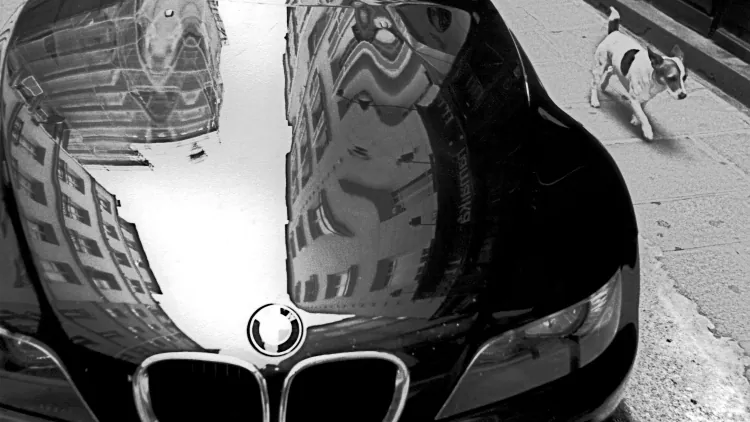Touch Screens Are Ruining Cars
Driving my old car has become a periodic deliverance back into the real.

One day in the early ’90s, my father came home with a used, champagne-toned Mercedes-Benz 300D four-door sedan. I was 9 or 10 and didn’t know anything about cars. But I was drawn to the luster of the diesel-powered slab of metal, the way the perforated leather smelled as it enveloped me, and how the wood grain on the dashboard and door panels made me feel as if I was involved in something far grander than merely commuting. The car, and the one that eventually replaced it—a larger, metallic-blue beauty, also preowned—felt substantive, meaningful, and distinctive.
The tougher boys in our neighborhood cared enough about Benzes to steal their hood ornaments. My older brother and friends would eventually school me on the finer points of German engineering, as well as its drawbacks (my parents’ eyes watered at the price of replacing a headlight or windshield wiper). But even as the most unsophisticated passenger, I could never mistake the interior of my father’s old Mercedes with that of any other car.
My daughter is 10 now, and she recently rode in a Tesla taxi for the first time. How was it? I asked. “Kind of cool,” she said, half-heartedly, “because it was like my iPad.” She understood that the Tesla is basically a computer full of distracting and gratuitous applications, and it just happened to perform some locomotive functions.
This iPad-ization of consumer reality is becoming harder and harder to resist. Vacuums now come equipped with screens, so do toasters, and even trash cans have motion sensors and voice control and companion apps you can download to your smartphone. Finding the analog versions of every product can take effort, and nowhere has this become truer than in the automotive realm.
[Rich Cohen: Here’s to a new generation of classic cars]
This is not an issue specific to electric vehicles—virtually all modern cars are now just slick screens connected to giant, mobile computing systems that operate with a complexity, and often a fragility, none of us can handle independently. But the “innovations” have introduced a slew of new problems. Long gone are the days when a handy guy like my brother could perform a Sunday-afternoon tune-up in his driveway. Several years ago, when he owned a brand-new Range Rover Sport—as wildly depreciating an asset as you can imagine—one of the quirks of its high-tech internal circuitry was that it would not start if parked under direct sunlight. He often had to drive complimentary rental cars while his state-of-the-art SUV was being serviced by the experts. Just last week, he met me for lunch in a U-Haul truck because the computer in his girlfriend’s BMW X6 had stopped safely regulating the car’s suspension.
On the level of aesthetics, the supposed innovations have led only to conformity and mediocrity. Even the interior of a new Mercedes-Benz S-class, luxurious as it is, with its immersive flatscreens and pastel-purple mood lighting, resembles every other new car—or indeed a hookah lounge—more than it does the singular models that preceded it.
Electric vehicles are simply at the forefront of the soul-crushing tendency to reduce everything that was once seductively human and endearingly—sometimes transcendentally—imperfect and unique to the impersonal, tech-saturated level of pretty nice. Could a child ever dream about a Lucid or Rivian? These are generically good-looking, low-emissions vehicles that only a cyborg could lust over. They are songs sung through Auto-Tune, with clever and forgettable lyrics composed by ChatGPT. (The one exception is Tesla’s otherworldly Cybertruck, whose jointless, audacious geometry looks more sculpted than welded, an extraordinary example of forward-looking design.)
In late March, the Biden administration announced, according to The New York Times, “one of the most significant climate regulations in the nation’s history, a rule designed to ensure that the majority of new passenger cars and light trucks sold in the United States are all-electric or hybrids by 2032.” I may not have not have noticed the announcement, except that, with awful timing, it came the same week a friend of mine from college died horrifically when his EV’s battery exploded. Supposedly this happens rarely, but in New York City alone last year, EVs caused more than 250 fires and killed 18 people. Heat moves through the battery cell by cell until it sets off a chain reaction called a “thermal runaway.”

Like everyone I know, climate change concerns me, a worry always simmering on my mind’s back burner. But the filthy, all-too-often coal-based power that fuels EV batteries is not going to save us without far more serious and pervasive energy reforms and innovations. Procuring the lithium for those batteries is a dirty business, as is disposing of it. All of this and more is why, when I moved to France in 2011 and my New York State driver’s license expired, I didn’t bother to renew it. The world didn’t need another car owner. I lasted more than a decade relying on my feet, bikes, scooters, subways, and Ubers—happily not driving.
[Annie Lowrey: Why did cars get so expensive?]
That changed last winter, when I began spending part of the year teaching in New York’s Hudson Valley. What you can get away with in densely populated urban environments is inconceivable upstate. I had to retake the tests for my license and quickly find a car to get to campus.
Every new option I considered was either far too expensive or looked profoundly uninspiring. Then I talked with a friend of my brother’s—one of those kids who used to yank off the hood ornaments. He now works as a mechanic for Audi and in his spare time buys used German cars at auction and repairs them. Sometimes he keeps them, and sometimes he sells them to friends.
Which is how I found myself with a silver 2004 Mercedes-Benz E 320, in which the scent of the interior never fails to work its Proustian sorcery. It has buttons to press and switches to flip and no touch screens; the dashboard isn’t digital. There is a lot of toasted walnut to contrast with the gray of the leather. The car exerts a weight over the pavement, and you feel a tactile heft to the steering wheel’s slow rotation—the polar opposite of the video-game-controller levity of cars today, which you can manipulate with a single index finger.
I love this Benz, which is so old now, it no longer looks dated. It has nothing in common with the many other technologies that have permeated my waking hours. The time I spend in this car, I feel liberated from the artificial, algorithmic superstructure that surrounds me, focused with undivided intensity on the road that is peeling back beneath me. Driving has become a periodic deliverance back into the real.
I do not ever intend to buy a new automobile. I don’t want to drive an EV—and I certainly don’t want it to drive me—just as I have no desire to pay for another internal combustion engine to be created. I want to give fresh life to old, reliable cars, the way the friends of mine who care the most about music want to sink into their sofas and listen to vinyl records.
I know I’m not the only one overcome by this sense of nostalgia. “God, I love that smell,” my friend Aatish said when I picked him up for dinner recently. He has two cars upstate, a brand-new Audi and a very old Ford Bronco. The last time I saw him, he was feeling shaken. The battery in his Audi had failed on the highway and then, he said, because everything in the car was electronic, the rest of the car failed too—all the way “down to the gas pedal. It was like being in Apollo 13.”
He was back to driving his Bronco.
What's Your Reaction?




















